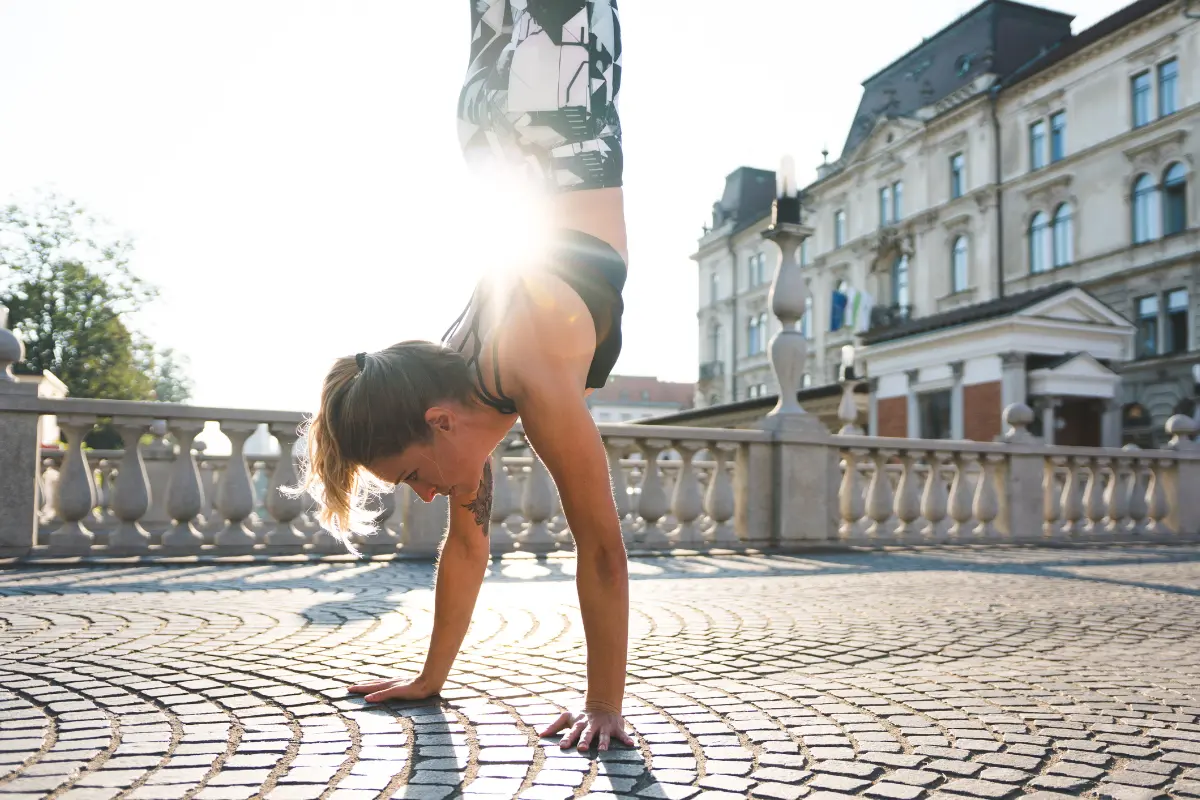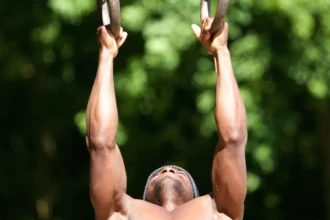Learning to hold a handstand can be a fun and rewarding challenge, but it’s not always easy. Whether you’re aiming to build strength, improve balance, or just show off your skills, holding a handstand for an extended period takes practice and technique. In this guide, we’ll walk you through the steps to not only get into a handstand but also hold it steady for as long as you can.
Step 1: Get Into Position
Before you can kick up into your handstand, you need to get into the right starting position. This is where your foundation begins, so it’s essential to set yourself up correctly.
The best way to start a handstand is with a lunge. A lunge gives you balance, momentum, and a strong base to launch from. Here’s how to get into it:
- Stand tall with your feet about hip-width apart.
- Step one foot forward into a lunge position, bending both knees to form a 90-degree angle with the back knee almost touching the ground. Your front knee should be directly above your ankle.
- Position your arms by your sides and prepare to kick up.
Once you’re in the lunge, you’ll use this position to transition into the handstand. It’s important to consider which leg feels most natural to raise into the air. For most people:
- If you’re right-handed, your left leg will likely go up first.
- If you’re left-handed, you’ll probably feel more comfortable raising your right leg.
But ultimately, go with whichever leg feels the most natural for you. Practice both sides to see which one gives you the most control. This will set you up for success when you’re ready to kick up into the handstand.
Step 2: Kicking Up Into the Handstand
Now that you’re in position, it’s time to focus on the kick-up—the motion that will get you into the handstand. This step can be tricky at first, but with practice, you’ll get the hang of it.
Prepare to Kick: From your lunge position, shift your weight forward slightly so your hands are firmly planted on the ground. Your arms should stay straight and strong, with your shoulders pushed up toward your ears.
Kick Up Lightly: Start by kicking one leg up into the air, leading with the leg that is behind (in your lunge). The goal is not to kick with too much force, but just enough to get your feet off the ground. Think of it as a gentle push-off rather than a big jump.
- If you’re kicking with your left leg (as a right-handed person), your left leg should come up first, followed by the right leg, bringing you into a straight position.
- If you’re left-handed, do the same, just with the opposite leg.
Use a Wall for Support: If you’re nervous about falling, or if you’re still building confidence, practice kicking up into a handstand against a wall. This will help you get comfortable with the movement and ensure you’re not worrying about falling over. You can also use a soft surface like a bed or a mat to cushion your fall as you get the feel for the motion.
Controlled Kick-Up: As you kick, aim to kick all the way up into the handstand. It might take a few tries, but don’t be discouraged. The goal here is to get both legs into the air with your body aligned straight. If you’re having trouble, don’t worry about staying up for long—just focus on getting the movement correct.
Safe Falling: If you do happen to fall, it’s important to know how to do so safely. Fall into a bridge (arched back position) rather than crashing straight down. This keeps your arms and back strong and prevents injury. Always keep your arms straight and steady, and you’ll land safely without a problem.
Step 3: Perfect Your Form
Now that you can get into a handstand, the next key step is perfecting your form. Good form is crucial for both balance and holding the handstand for an extended period. Even a slight shift in posture can throw you off, so it’s essential to focus on alignment and body engagement.
Here’s how to perfect your handstand form:
1. Arms and Shoulders
Your arms should be strong and straight, with your shoulders pushed up toward your ears. Think of your arms as extensions of your body, forming a straight line from your fingertips to your feet. Avoid letting your arms wander too far apart or bend at the elbows. This will not only keep your handstand stable but also prevent injury.
- Tip: When you’re in the lunge position, your arms should already be aligned with your ears, and they should stay there when you kick into the handstand.
2. Engage Your Core
A strong core is the foundation of a stable handstand. If your core is engaged, your body will stay straight and balanced. To do this, imagine pulling your belly button in toward your spine to activate your abdominal muscles. Avoid letting your back arch or your stomach hang loose, as this will throw off your balance.
- Tip: Keeping your core tight prevents your body from swaying or falling out of the handstand. Engage it as soon as you begin the kick-up and keep it engaged throughout.
3. Tuck Your Butt In
Another important part of handstand form is keeping your glutes (butt muscles) engaged and tucked. If your butt sticks out too much, it can throw off the alignment of your body. By keeping your glutes in, you’ll help maintain a straight line from your wrists to your toes.
- Tip: Think about tucking your pelvis slightly under you. This will help prevent your back from over-arching and make your handstand more stable.
4. Push Up Through Your Shoulders
A key difference between a wobbly handstand and a stable one is how much you push up through your shoulders. This is a game-changer for balance. By pushing your shoulders upward, you extend your body toward the sky and create more height and stability. Think about actively reaching your arms higher, as though you’re trying to touch the ceiling with your fingertips.
- Tip: Watch the difference in your body when you push through your shoulders. The second you start reaching for the sky, you’ll notice the stability improves.
5. Squeeze Your Thighs Together and Point Your Toes
For both balance and aesthetics, squeezing your thighs together and pointing your toes is essential. When your legs are together and straight, it helps prevent wobbling, and pointed toes give your handstand a polished, controlled look. It’s also easier to balance when your legs are aligned rather than apart.
- Tip: Imagine your legs are like one long line from your fingertips to your toes. This alignment makes it easier to stay stable.
The more you focus on maintaining proper form, the longer you’ll be able to hold your handstand with ease.
Step 4: Use Your Fingers for Control
Once you’ve perfected your form and can kick up into your handstand with confidence, the next key element is learning how to use your fingers for better balance and control. This might seem like a small detail, but it can make a huge difference when it comes to holding your handstand for longer periods.
Here’s how to use your fingers to keep your balance in check:
1. Spread Your Fingers
When you’re in your handstand, your hands are your main point of contact with the ground. To gain better control, spread your fingers wide apart. This gives you a larger surface area to balance on and helps you grip the ground more effectively.
- Tip: Think of your fingers like tree branches. The wider you spread them, the more grounded and stable you’ll feel.
2. Teeter-Totter Technique
One of the most helpful tricks to maintain balance in a handstand is the teeter-totter method. Imagine your hands acting like a seesaw—when you start to lean too far forward, you can use your fingers to shift the balance back.
- How to do it: If you feel yourself tipping forward, curl your fingers slightly at the front to push back and regain your balance. If you feel yourself tipping backward, shift your weight toward the palm of your hands and use your fingers to gently pull yourself back into the center.
This technique helps you make small adjustments without falling, allowing you to maintain your handstand for longer periods.
3. Practice on All Fours
Before you take this to your full handstand, try practicing the finger control technique on all fours. Get into a tabletop position (hands and knees on the ground) and practice shifting your weight and using your fingers to stabilize. This will help you build awareness of how to move and adjust the weight in your hands.
- Tip: Once you feel comfortable using your fingers to balance while on all fours, transfer this awareness to your full handstand.
4. Fine-Tune Your Balance
Fingers are a small but powerful tool in your handstand toolkit. With practice, you’ll develop the ability to use your fingers to make precise adjustments, which will help you find your “center” of balance. The more you practice, the better you’ll get at using your fingers to correct minor imbalances without overcompensating.
Step 5: Strengthen Your Upper Body
To hold a handstand for a long time, you need more than just technique and form—you also need strength. Your upper body plays a crucial role in maintaining that perfect handstand position. Specifically, your arms, shoulders, and core need to be strong enough to support your body weight and keep you balanced.
To achieve this, incorporate targeted upper body exercises into your routine. As your upper body strength improves, you’ll find that you can hold your handstand with greater stability and for a longer duration.
Step 6: Practice Breathing
Breathing is often overlooked when practicing handstands, but it plays a vital role in maintaining control and balance.
To improve your stability and focus, make it a habit to inhale deeply before you kick into the handstand, and exhale slowly as you stabilize. This rhythmic breathing helps keep your core engaged and enhances your overall balance.
Try to breathe through your nose rather than your mouth; it not only helps you maintain better control but also keeps you calm and focused. Proper breathing encourages a smoother, more controlled handstand, allowing you to hold the position for a longer time without feeling tense or losing your balance.
Step 7: Add Variations for Fun
Once you’ve mastered the basic handstand, adding fun variations can not only improve your skills but also keep your practice exciting and engaging. These variations help challenge your balance, build strength, and add a creative flair to your handstand routine. Here are a few fun handstand variations to try once you’re comfortable holding the basic position:
1. The Double Stag
One variation that’s easier to balance than a regular handstand is the double stag. In this position, you spread both legs apart in a bent knee position, creating a “V” shape with your legs. The extra width helps balance the weight more evenly, making it easier to hold the handstand.
- How to do it: Kick up into the handstand, then slowly bend your legs and open them out to the sides, keeping your knees bent at 90 degrees. This variation not only improves your balance but also looks impressive in photos!
2. Handstand Split
Another fun handstand variation is the handstand split, where you separate your legs in a split position while upside down. This variation challenges your flexibility and balance while making for an eye-catching pose.
How to do it: Once you’re in the handstand, engage your core and slowly split your legs apart. Try to get your legs as straight as possible to make the split more dramatic. Remember to focus on keeping your body aligned while in this position.
3. Handstand Push-Ups
For a more advanced variation, try adding handstand push-ups to your practice. This exercise targets your shoulders, arms, and core, and it’s a great way to build upper body strength for holding handstands longer.
- How to do it: From your handstand position, bend your elbows to lower your head toward the ground, then press back up to your starting position. Start slowly and make sure your form is solid to avoid injury.
Sometimes, the best way to improve is by seeing yourself in action. Filming yourself as you practice handstand variations can provide valuable feedback and help you assess your form, balance, and technique.
Final Thoughts
The most important tip for mastering the handstand is simple: practice. Like anything, the more you practice, the better you get. Don’t expect overnight success, but with daily practice, you’ll see improvement. It’s important to stay persistent and keep trying, even if you feel like you’re not making progress. Every practice session is a step toward getting better.






